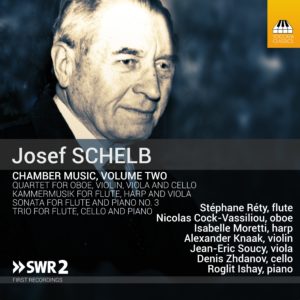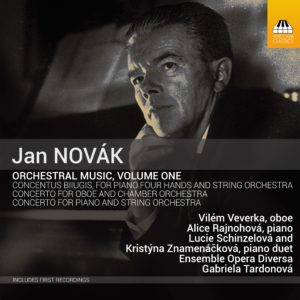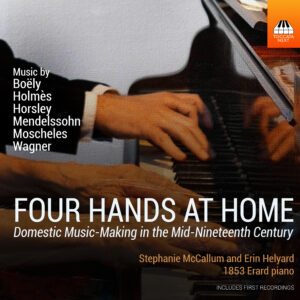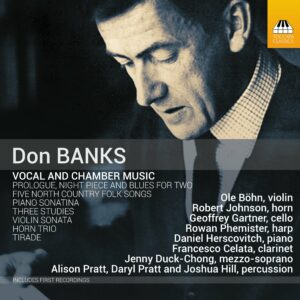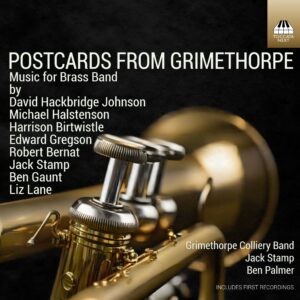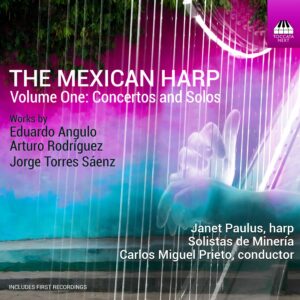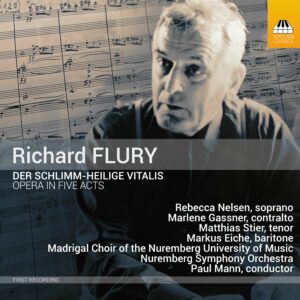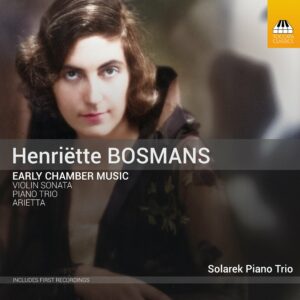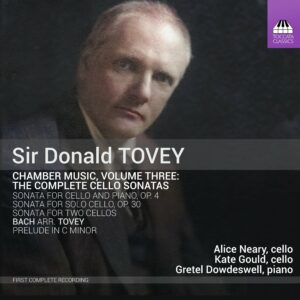Search Results for "fantastic four first steps online free 123movies"
Showing results for fantastic four first steps online free movies movies
Robert Fürstenthal: Complete Choral Music, Volume One
Like many Austrian Jews, Robert Fürstenthal (1920–2016) fled to the USA after the German invasion of his country in 1938. Music then became a link to his homeland: ‘When I compose, I am back in Vienna’. As an amateur composer, Fürstenthal preferred to work on a small scale, and his output of songs and chamber music is considerable. But he also wrote two sizable works for chamber choir, the first of which, in this series of two albums, is bookended by piano sonatas – all three works revealing that the tradition of Schubert and Brahms was alive in the California sun.
Ian Buckle, piano (Tracks 1–4, 16)
Richard Casey, piano (Tracks 5–10, 12–16)
Philippa Hyde, soprano (Tracks 6, 8, 12, 14)
Emma Roberts, contralto (Tracks 6, 7. 9, 12–15)
Rory Carver, tenor (Tracks 5–7, 10, 12, 14, 15)
Felix Kemp, bass (Tracks 5–7, 14)
Borealis (Tracks 5, 6, 8, 10, 13–15)
Skipton Camerata (Tracks 5–8, 10–15)
Stephen Muir, conductor (Tracks 5–15)
Josef Schelb: Chamber Music, Volume Two
The Karlsruhe-based Josef Schelb (1894–1977) is one of the better-kept secrets of twentieth-century German music. His output was substantial: he lost most of his early music in a bombing raid in 1942, but – as if to make up for lost time – wrote some 150 more works after that. In the four chamber works recorded here Schelb’s contrapuntal mastery is given a bucolic twist under the influence of French Impressionism, the two traditions combining to invest these pieces with a freewheeling energy and downright sense of fun.
Stéphane Réty, flute (Tracks 1-9)
Nicolas Cock-Vassiliou, oboe (Tracks 10–12)
Isabelle Moretti, harp (Tracks 1–3)
Alexander Knaak, violin (Tracks 10–12)
Jean-Eric Soucy, viola (Tracks 1–3, 10–12)
Denis Zhdanov, cello (Tracks 7–12)
Roglit Ishay, piano (Tracks 4–9)
Jan Novák: Orchestral Music, Volume One
The music of the Moravian composer Jan Novák (1921–84) – a natural successor to Bohuslav Martinů, with whom he briefly studied – is nothing less than life-enhancing: it has Martinů’s rhythmic charge and his unflagging energy. And although Novák had such difficulties with the authorities in Communist Czechoslovakia that he chose to emigrate, there is an infectious optimism, a joie de vivre, in these three works that is instantly communicative.
Alice Rajnohová, piano (Tracks 1–3)
Vilém Veverka, oboe (Tracks 4–6)
Lucie Schinzelová, piano duet – primo (Tracks 7–9)
Kristýna Znamenáčková, piano duet – secondo (Tracks 7-9)
Ensemble Opera Diversa
Gabriela Tardonová, conductor
Four Hands at Home: Domestic Music-Making in the Mid-Nineteenth Century
Playing piano four-hands was both vital in the dissemination of music in the nineteenth century and also a popular domestic activity. The original 1853 Parisian Erard piano on which this recording was made demonstrates the clarity, warmth and differentiated timbres characteristic of the ‘straight stringing’ that was later replaced by the ‘cross-stringing’ of the modern concert grand. The repertoire from the period covers the many genres of four-hand piano works in their varied roles as domestic ‘info-entertainment’: orchestral works large and small, serious sonatas and variations, showpieces for emerging virtuosi and even a string quartet are all equally engaging in this once-familiar medium.
Stephanie McCallum (primo) and Erin Helyard (secondo), 1853 Érard Piano
Don Banks: Vocal and Chamber Music
During his short life Don Banks (1923–80) enjoyed a reputation as the leading modernist among Australian composers. Studies with Mátyás Seiber, Milton Babbitt and, especially, Luigi Dallapiccola helped refine his serial technique, but his music never retreated into academic abstraction, as this recital of chamber and vocal works demonstrates: it retained a keen sense of drama, an ear for atmosphere, a rather angular lyricism and, occasionally, a touch of humour.
Robert Johnson, horn (Tracks 1–3)
Ole Böhn, violin (Tracks 1–3, 18)
Jenny Duck-Chong, mezzo-soprano (Tracks 4–8, 19–21)
Francesco Celata, clarinet (Tracks 9–11)
Geoffrey Gartner, cello (Tracks 12–14)
Rowan Phemister, harp (Tracks 19–21)
David Kim-Boyle, siren (Track 21)
Alison Pratt, Daryl Pratt and Joshua Hill, percussion (Tracks 19–21)
Daniel Herscovitch, piano
Postcards from Grimethorpe: Music for Brass Band
When the American composer Jack Stamp was appointed International Composer-in-Association to the Grimethorpe Colliery Band in 2019, he conceived a recording project focused on works specifically written for the GCB, including compositions by himself and Liz Lane, the other GCB Composer- in-Association, alongside other pieces which have played a prominent role in the Band’s recent activities. The kaleidoscopic range of styles to be heard here displays the extraordinary virtuosity of one of the world’s best-known brass bands.
Grimethorpe Colliery Band
Jack Stamp, conductor
Ben Palmer, guest conductor
¡Colombia Viva! Volume Two
With this second volume of ¡Colombia Viva! – a series capable of infinite expansion, as is indeed intended – Mauricio Arias-Esguerra embarks on another lightning tour of the recent piano music of his native country, displaying the wide variety of styles on offer there, from atmospheric modernism to catchy folk dances, a recurrent element being striking rhythmic vivacity.
Mauricio Arias-Esguerra, piano
In Handel’s Shadow: Vocal Music by his Rivals in 18th-Century London
The figure of George Frideric Handel cast a long shadow over musical London in the first half of the eighteenth century, condemning many of his contemporaries – fine composers themselves – to long years of obscurity. This recording throws light into forgotten corners and discovers some glittering gems, some of them demanding dazzling vocal fireworks from their performers. Several of these composers set scenes from Classical mythology or Old Testament narratives – but they also explore the underside of the Baroque psyche in one of David’s darkest psalms and in a representation of Arcadian madness.
Lux et Umbrae
Robert Crowe, soprano and artistic director
Annette Fischer, soprano
Julia Nilsen-Savage, cello
Sigrun Richter, archlute
Michael Eberth, harpsichord
Emánuel Moór: Music for Viola
The works of Emánuel Moór (1863–1931) ought to be celebrated as among the major achievements of Romantic music, but because of Moór’s peripatetic life – he was born in Hungary, studied in Vienna (with Bruckner), performed in the US and across Europe, became a UK citizen and settled and died in Switzerland – no country has claimed and promoted him to the degree he deserves. Moór’s musical language offers a deeply satisfying blend of contrapuntal mastery and ardent lyricism, as the works on this album – written for or involving the viola – demonstrate. In time he will be recognised as one of the masters of his age.
Dirk Hegemann, viola
Dávid Báll, piano (Tracks 3, 8, 9)
Rosenstein String Quartet (Tracks 1–2, 4–7):
Michael Hsu and SooEun Lee, violins
Dirk Hegemann, viola
Markus Tillier, cello
Anima Musicae Chamber Orchestra (Track 10)
Mátyás Antal, conductor (Track 10)
The Mexican Harp Volume One: Concertos and Solos
With this first Toccata Next album of Mexican music for harp, the American harpist Janet Paulus pays tribute to her adoptive country and to three composer friends, each with a concertante work and music for solo harp – several of them recently written for her. The predominant style is gently Neo-Romantic, occasionally animated with echoes of Mexican folk-music.
Janet Paulus, harp
Solistas de Minería (Tracks 2–5, 10-12)
Carlos Miguel Prieto, conductor (Tracks 2-5, 10-12)
Richard Flury: Der schlimm-heilige Vitalis, Opera in Five Acts
Der schlimm-heilige Vitalis (which can be translated roughly as ‘Lustful Brother Vitalis‘) was the last of the four operas by the Swiss composer Richard Flury (1896–1967). It was premiered in 1963, the year after its completion, and then remained unheard until this recording. The plot, based on a novella by Flury’s fellow Swiss, Gottfried Keller, sets jolly village life against religious intolerance and sexual politics in an unsettling blend of the sentimental and the cynical – although love, of course, triumphs in the end. Flury’s late-Romantic music redeems the libretto with a steady flow of memorable melodies, engaging solo and choral numbers, and colourful orchestration – and with a sense of fun never far from the surface.
Rebecca Nelsen, soprano
Marlene Gassner, contralto
Matthias Stier, tenor
Markus Eiche, baritone
Madrigal Choir of the Nuremberg University of Music
Alfons Brandl, chorus-master
Nuremberg Symphony Orchestra
Paul Mann, conductor
Dreams and Dances: Chamber Music for the Clarinet by the Krein Family
The Krein family, with its origins in Lithuania, became a musical dynasty of considerable importance in Imperial and then Soviet Russia. The seven sons of its patriarch, Abram Krein, were all musicians, with Alexander and Grigory becoming respected composers, and Grigori’s son, Yulian, adding another generation of Krein compositions. The dances and cantillation of their Jewish background was an important part of their musical make-up, combining at various stages with Russian folk-music, Skryabinesque harmony and French Impressionism. All three shared a predilection for the clarinet, developing a repertoire for the instrument that is only now beginning to be discovered – in what one might call a Krein scene investigation.
Anne Elisabeth Piirainen, clarinet
Iryna Gorkun-Silén, flute (tracks 4–6)
Lea Tuuri, violin (Tracks 1, 2, 9–11, 14–16)
Maria Puusaari, violin (Tracks 1, 2, 9–11)
Jussi Aalto, viola (Tracks 1, 2, 9–11)
Pinja Nuñez, cello (Tracks 1, 2, 9–11, 14–16)
Kirill Kozlovski, piano (Tracks 3–8, 12–16)
Henriëtte Bosmans: Early Chamber Music
The three works by the Amsterdam-born Henriëtte Bosmans (1895–1952) in this album all date from her early to mid-twenties. The Violin Sonata and Piano Trio are substantial pieces, both animated by the passion of youth – and, given their quality, it is astounding that they should be receiving their first recordings here. At this stage in her life Bosmans was still writing in an expansive, Romantic style, although echoes of French Impressionism, Spain and the Middle East can often be heard – and from time to time the Violin Sonata nods to Bach and Reger.
Solarek Piano Trio
Marina Solarek, violin
Miriam Lowbury, cello
Andrew Bottrill, piano
Sir Donald Tovey: Chamber Music, Volume Three: The Complete Cello Sonatas
Sir Donald Tovey (1875–1940), long hailed as one of the finest writers on music in English, saw himself primarily as a composer. His occasionally turbulent friendship with Pau Casals was the spur for a monumental concerto and one of his three cello sonatas: for solo cello, two cellos and cello with piano. The cello was the ideal instrument for Tovey’s Brahmsian musical language, with its long, singing lines unfolding in effortless counterpoint – though the huge passacaglia that ends the solo sonata also demands a virtuoso technique. The brief Bach arrangement recorded here for the first time arose when the twelve-year-old Tovey added a cello line to one of Bach’s best-known preludes, originally for lute.
Alice Neary, cello
Kate Gould, cello (Tracks 1–3)
Gretel Dowdeswell, piano (Tracks 4, 8–10)
A Century of American Viola Sonatas
These five works – four sonatas and a sonatina – chronicle a century of American writing for the viola and are linked by a concern for directness of musical language. But they also reflect diversity in their origins and inspirations, the Ulysses Kay pieces being written by a pioneering African American, Libby Larsen’s by a successful female freelance composer, Eric Ewazen’s animated by a particularly American lyricism and energy, and the sonata by David Tcimpidis commemorating the ‘9/11’ terrorist attack on the World Trade Center, which Tcimpidis heard unfolding.
Basil Vendryes, viola
William David, piano
Jack Stamp: Chamber Music, Volume One
The American composer John Stamp (b. 1954) – universally known as ‘Jack’ – is a familiar figure in the worlds of the symphonic wind-band movement that flourishes in US universities and of the brass band on both sides of the Atlantic. This first Toccata Classics album of his music presents a cross- section of recent works for woodwinds, brass and strings, varied in mood, from upbeat to reflective, and in style, from a solemn hymn-setting to buoyant, outdoors Americana à la Copland, now and then coloured by a hint of jazz.
Uptown Brass
Mill City Chamber Players
Hideaway Wind Quintet
Whittier String Trio
Marissa Benedict, Charles Lazarus, trumpets
University of Minnesota Jazz Ensemble
Jack Stamp, Dean Sorenson, conductors
Stay In the Know
JOIN THE TOCCATA NEWSLETTER
"*" indicates required fields
By visiting our site, you agree to our privacy policy regarding cookies, tracking statistics, etc.

